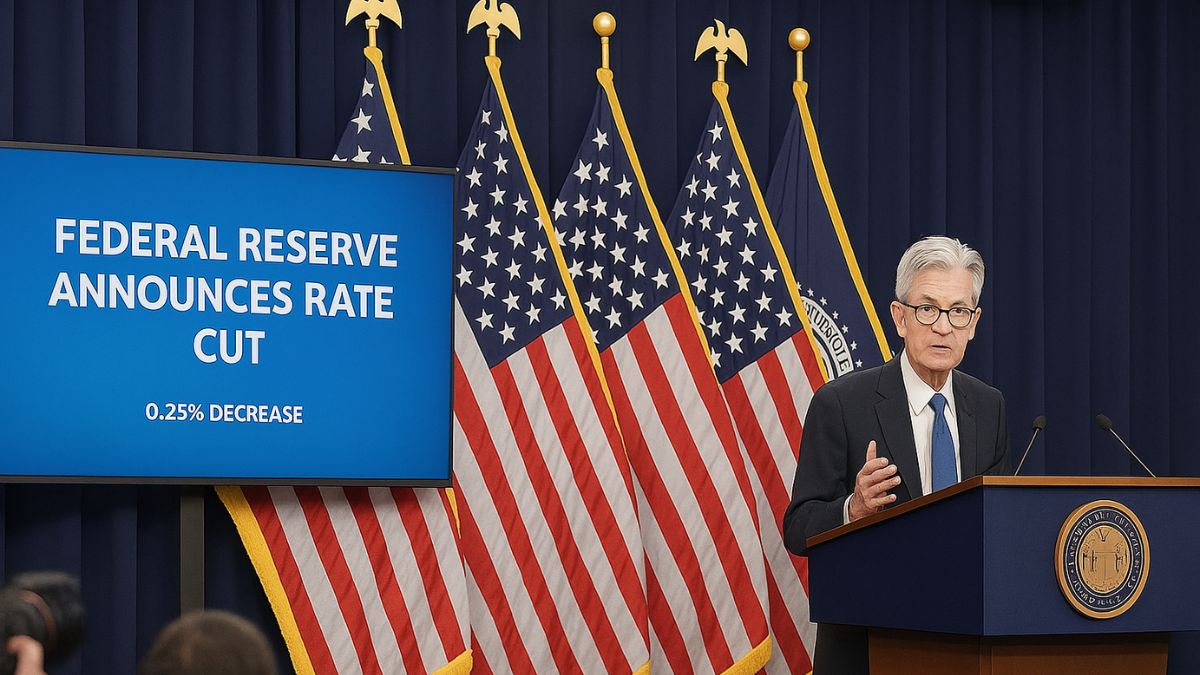Federal Reserve Delivers Expected Rate Cut Amid Shocking Policy Uncertainty
The Federal Reserve’s Federal Open Market Committee, led by Chairman Jerome Powell, executed a widely anticipated 25 basis point interest rate reduction on October 29, 2025, bringing the benchmark federal funds rate to a new target range of 3.75-4.00 percent. However, what should have been a routine policy announcement exploded into dramatic market upheaval when Powell’s post-meeting press conference revealed stunning divisions within the committee and signaled an abrupt halt to the anticipated easing cycle. The Federal Reserve rate cut decision carried far greater significance than mere numerical adjustments—it represented a fundamental pivot in global monetary policy that would reverberate through asset prices worldwide.
The decision came through a contentious 10-2 vote, marking the most divisive monetary policy action in recent years. Two committee members forcefully dissented: Governor Stephen Miran advocated for an aggressive 50 basis point cut, while Kansas City Federal Reserve President Jeffrey Schmid demanded no rate change whatsoever, creating unprecedented division that shocked financial markets and rattled investor confidence.
This represents only the second rate reduction in 2025, following September’s initial quarter-point cut. The twin reductions come after months of monetary tightening that dramatically elevated rates to combat inflation, culminating in the previous 5.25-5.50 percent target range that constrained borrowing costs and devastated asset prices globally.
Powell Shatters Market Dreams – December Cut “Far From Foregone Conclusion”
The real shock materialized when Jerome Powell stepped to the podium and delivered emotionally charged language that shattered Wall Street’s euphoric expectations. Powell stated emphatically that “a further reduction in the policy rate at the December meeting is not a foregone conclusion. Far from it,” signaling an abrupt policy pivot that sent shockwaves through global financial markets.
Prior to Powell’s remarks, financial markets had confidently priced in a 90+ percent probability of a December rate reduction, representing collective Wall Street consensus. However, Powell’s powerful and carefully chosen language immediately collapsed those expectations. By Wednesday afternoon, December rate-cut probability plummeted to merely 56-68 percent—a devastating 30+ percentage point reversal in just hours.
“There are strongly differing views about how to proceed in December,” Powell acknowledged, exposing internal committee divisions rarely revealed to markets with such candor. The admission signaled Powell’s willingness to embrace policy uncertainty rather than provide the forward guidance that typically anchors market expectations.
Powell elaborated on the Fed’s paralysis, acknowledging the impossible balancing act: “We have one tool, and you cannot address both employment and inflation risks at once.” This emotionally resonant statement captured the Fed’s genuine policy dilemma, torn between protecting vulnerable employment against persistent inflation threats.
Quantitative Tightening Ends December 1 – Liquidity Reversal Begins
Amid the monetary policy uncertainty, the Fed announced a significant structural shift in its balance sheet management. The Committee declared that its aggressive quantitative tightening (QT) program—which has been systematically shrinking the Fed’s $7+ trillion securities portfolio since 2022—will conclude on December 1, 2025.
This announcement carries enormous implications for financial market liquidity. Instead of allowing securities to mature and roll off its balance sheet (reducing monetary reserves), the Fed will reverse course and reinvest maturing Treasury holdings and mortgage-backed securities proceeds into new Treasury bill purchases. This policy shift effectively transforms the Fed from a net seller to a net purchaser of government securities, reversing deflationary pressures that have characterized recent years.
The QT program conclusion reflects growing anxiety about banking system liquidity adequacy. Recent weeks have witnessed firming money market yields and deteriorating liquidity conditions that signal banking reserves—now severely depleted after years of balance sheet reduction—are approaching dangerously scarce levels. The Fed prioritizes avoiding ANY possibility of financial system stress, making the QT conclusion a critical defensive measure.
Market Volatility Erupts on Powell’s Hawkish Pivot
The immediate market response revealed the raw power of Powell’s shocking commentary. Stock indices that had rallied smartly ahead of the rate cut announcement reversed dramatically downward as Powell spoke. The S&P 500 surrendered all gains and turned decisively negative, declining 0.3 percent by late afternoon trading.
Treasury yields spiked violently, with 2-year Treasury yields surging 9 basis points as bond investors fled, expecting extended monetary tightening contrary to earlier easing assumptions. The dramatic 9 basis point move in a single afternoon represents extraordinary volatility that telegraphs the severe market disappointment.
Cryptocurrency markets experienced violent liquidations, with Bitcoin plunging from $113,000+ toward $111,000-$112,000 as traders unwound leveraged long positions betting on continued monetary easing. The digital asset liquidation cascades demonstrated how completely market participants had positioned for an easing supercycle that Powell’s remarks shattered.
The US dollar strengthened sharply, advancing 0.2 percent to 98.87 on the dollar index, as elevated real interest rates attracted foreign capital seeking returns in US government securities. This dollar strength devastates emerging market assets denominated in weaker local currencies, creating tremendous headwinds for India and other developing economies.
Government Shutdown Creates Economic Data Vacuum
Powell’s cautious stance carries particular weight given the extraordinary government shutdown that has crippled economic data collection since October 1, 2025. Critical monthly employment reports—which typically anchor Fed policy decisions—remain unreleased, forcing Powell to rely on fragmented private-sector indicators and anecdotal evidence rather than authoritative government statistics.
The absence of official employment data represents an unprecedented policy challenge. The September payroll figures, normally released in early October, remain trapped in bureaucratic limbo due to congressional funding failures. This data drought creates palpable anxiety that the Fed may be cutting rates blindly without understanding actual labor market conditions.
“We have been relying on private-sector data and anecdotal reports from around the country,” Powell acknowledged during his press conference, highlighting the genuine uncertainties confronting monetary policymakers. The admission underscores why Powell adopted an extraordinarily cautious posture—without government data, committing to December rate cuts represents unacceptable policy risk.
Federal Funds Rate Trajectory Mirrors Neutral Policy Stance
Powell emphasized during his remarks that the new 3.75-4.00 percent target range represents closer approximation to the Fed’s long-term “neutral” interest rate—estimated around 2.5-3.0 percent by most economists. This neutral rate neither stimulates economic growth nor constrains it, suggesting limited additional rate cut capacity remains.
The implication cuts deeply: markets should expect dramatically slower rate reduction pace going forward, with December cuts perhaps representing terminal moves in the easing cycle rather than the beginning of aggressive rate reductions that markets initially anticipated. This represents a fundamental recalibration of monetary policy expectations that will ripple through asset prices globally.
Emerging Market Turmoil – India Bears Brunt of Rate Reassessment
Emerging market equities experienced sharp selling as Powell’s hawkish pivot triggered capital flight back to developed market safe havens. India faces particular vulnerability given substantial foreign portfolio investor exposure to Indian equities and bonds valued at approximately $80+ billion. The rapid Fed policy reassessment triggers immediate repatriation of foreign capital seeking higher US Treasury yields.
The Reserve Bank of India confronts parallel pressures as elevated US interest rates attract international capital, weakening the Indian rupee and threatening imported inflation amplification. RBI policy flexibility—which had expanded with expectations for Fed rate cuts—suddenly contracts as US monetary tightening reasserts dominance over global financial conditions.
Indian corporate borrowers face immediately elevated costs as rupee weakness increases the US dollar value of rupee-denominated debt service obligations. Multinational corporations operating in India suddenly confront transformed economics as rupee depreciation intensifies.
Committee Dissents Expose Deeper Disagreements
Beyond the headline rate cut decision, the dissenting votes carry tremendous symbolic weight. Governor Miran’s advocacy for an aggressive 50 basis point cut signals desperation about employment weakness, while President Schmid’s “no change” preference reflects inflation anxiety. The visible disagreement exposes fundamental philosophical divisions rarely exposed so explicitly.
Christopher Waller, a known hawk, presumably lurked among the 10-vote majority, potentially restraining his instincts regarding further easing. This internal compromise positioning—where Waller subordinates rate-cut preferences for majority voting unity—creates precarious consensus vulnerable to collapse if economic data shifts.
Trump Administration Pressure Complicates Powell’s Independence
Complicating Powell’s policy decisions is the Trump administration’s intense pressure on monetary policy. Trump has repeatedly criticized Powell, derisively calling him “Jerome ‘Too Late’ Powell” for allegedly moving too slowly on rate reductions. The White House is actively evaluating Powell’s replacement, with an announcement expected before year-end, creating implicit pressure to appear neither dovish nor dovish-biased.
Powell’s cautious stance may partially reflect efforts to project policy independence and resist Trump’s pressure for dramatic rate cuts that could overheat the economy or restart inflation. The political economy of Powell’s decision-making introduces troubling ambiguity regarding pure economic considerations versus political calculus.
What Happens Next – The December Gamble
Markets now confront genuine uncertainty regarding the December policy decision. The government shutdown’s resolution may unlock employment data that either justifies December cuts (if labor market weakness materializes) or supports continued tightening (if employment stabilizes).
Depending on whether Congress resolves the shutdown and releases delayed employment reports, the Fed may possess dramatically different information sets by December’s meeting. This potential data revelation creates binary policy scenarios—aggressive December cuts or extended tightening—with massive market implications.
Most analysts expect December rate cut probability will gradually recover toward 60-70 percent if economic data disappoints. However, Powell’s powerful language suggests even if data supports cuts, the Fed may pause to emphasize data dependence and policy caution.
Global Central Bank Policy Implications
The Fed’s dramatic policy pivot reverberates through global monetary policy settings. Bank of Canada announced a contemporaneous 25 basis point rate cut to 2.25 percent, but faces parallel pressures regarding future reductions amid US policy tightening. European Central Bank officials reassess November/December easing prospects given potential Fed policy pause.
The Reserve Bank of India similarly confronts recalculated calculus regarding independent easing capacity. RBI’s December rate decision suddenly carries transformed implications if Fed policy likely tightens through 2026. Central bank policy interdependence creates constraints on national monetary policy autonomy.
Conclusion
The Federal Reserve’s October 29 rate cut decision masked a dramatically different underlying reality: Powell’s shocking declaration that December rate cuts represent no certainty fundamentally reframed the monetary policy outlook. The division reflected in dissenting votes and Powell’s candid acknowledgment of “strongly differing views” exposed genuine Fed uncertainty that markets must now navigate. The government shutdown’s elimination of official economic data compounds the uncertainty, leaving the Fed dependent on fragmented information sources for December’s critical decision.
Emerging markets including India face renewed capital flight pressures and rupee weakness as investors reassess carry trade assumptions. The era of anticipated continued monetary easing appears to have ended abruptly, replaced by genuine policy uncertainty that markets will struggle to price until clearer economic signals emerge post-shutdown. Powell’s powerful language—”far from foregone conclusion”—will reverberate through financial markets for months, reminding investors that monetary policy certainty represents a luxury that today’s fractious Fed simply cannot provide.


























